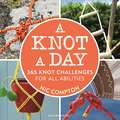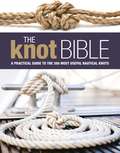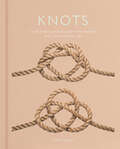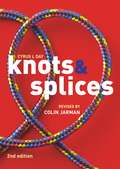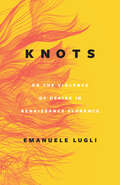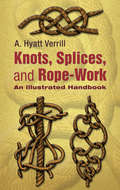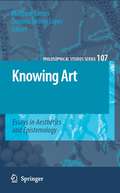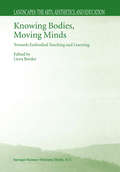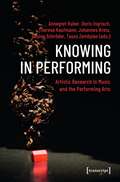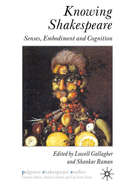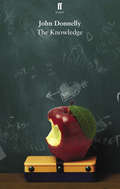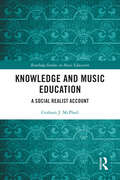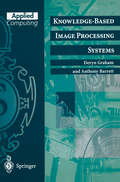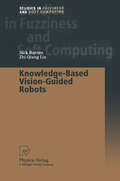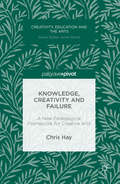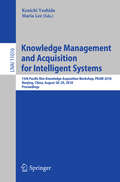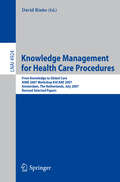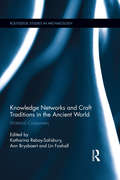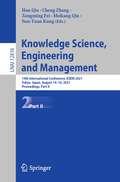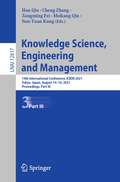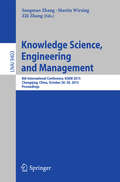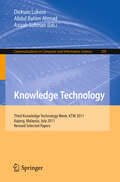- Table View
- List View
A Knot A Day: 365 Knot Challenges for All Abilities
by Nic ComptonThis beautifully produced compendium gives you a knot challenge for every day of the year. With hundreds to choose from, all colour coded by use, you can work through the book from start to finish, gradually building on your knowledge as you go, or alternatively dipping in and out for your daily knotting fix.Covers:- all the essential knots- useful hitches, bends, whippings and splices- handy knots for making outdoor items: plant hangers, harnesses, tree swings, rope ladder- mini knot craft projects: cool keyrings, friendship bracelets, belts, mats- magic 'trick' knots: escapology knots, vanishing knots, travelling knots- freestyle knots: have a go at the 'thrown bowline' (an old cowboy trick)- everyday fashion knots - new ways to tie your shoelaces, scarf, or even your tie!You won't escape this book without learning something, and you won't put it down without picking up an interesting fact or useful technique. Give it a month and you'll be a knot tying fanatic; give it a year and you'll be a knotting supremo!
A Knot A Day: 365 Knot Challenges for All Abilities
by Nic ComptonThis beautifully produced compendium gives you a knot challenge for every day of the year. With hundreds to choose from, all colour coded by use, you can work through the book from start to finish, gradually building on your knowledge as you go, or alternatively dipping in and out for your daily knotting fix.Covers:- all the essential knots- useful hitches, bends, whippings and splices- handy knots for making outdoor items: plant hangers, harnesses, tree swings, rope ladder- mini knot craft projects: cool keyrings, friendship bracelets, belts, mats- magic 'trick' knots: escapology knots, vanishing knots, travelling knots- freestyle knots: have a go at the 'thrown bowline' (an old cowboy trick)- everyday fashion knots - new ways to tie your shoelaces, scarf, or even your tie!You won't escape this book without learning something, and you won't put it down without picking up an interesting fact or useful technique. Give it a month and you'll be a knot tying fanatic; give it a year and you'll be a knotting supremo!
The Knot Bible: The Complete Guide to Knots and Their Uses
by Bloomsbury PublishingThe complete and definitive bible of knots for seafarers.Featuring all the knots, hitches, bends, splices, whipping and decorative knotwork that you would find on a boat, this comprehensive bible of knots will help those who go to sea master every knot they will need.Over 200 knots are scored for strength, reliability, ease of tying (and untying) and usefulness. Step by step photographs show how to tie each knot, and demonstrate how they can be used, such as in the rigging or for tying boats up. Interesting knot know-how sections give extra information about the knot's history, plus helpful tips and techniques, including choosing the right rope for the right task and using the right knot.With a beautiful modern design, and highly illustrated with full colour photographs and instructive diagrams throughout, The Knot Bible remains accessible to all sailors of all levels of experience whilst still being the king of knot books.
Knots: An Illustrated Practical Guide to the Essential Knot Types and their Uses
by Barry MaultAn essential reference for those looking to expand their repertoire of knots, bends, and hitches, as well as for those seeking to simply learn the basics, this book features more than 50 knots, complete with clear step-by-step instructions.With helpful boxes on their use and beautiful full-colour photographs showing them in the world at large, this book provides the perfect introduction to an essential skill. Dip inside to discover:• special knots for sailing• clever knots for camping• handy knots for the home• and other knots that are simply a pleasure to tie!ABOUT THE SERIES: Arcturus Hobby Editions bring together beautiful hardback guides introducing a variety of hobbies with full-colour illustrations and images.
Knots and Splices: Knots, Bends, Hitches, Whippings, And Splices
by Colin JarmanKnots and Splices, first published in 1953, has been used by many thousands of sailors all over the world. The new edition of this much loved reference has now been completely revised to bring it up to date with modern developments. - Superb full colour photographs show the formation of each knot. - Refers to modern materials and their properties. - Covers knots, bends, hitches, loops, whippings, seizings and much more. A comprehensive pocket guide designed for anyone wanting to work with rope.
Knots, or the Violence of Desire in Renaissance Florence
by Emanuele LugliAn interdisciplinary study of hair through the art, philosophy, and science of fifteenth-century Florence. In this innovative cultural history, hair is the portal through which Emanuele Lugli accesses the cultural production of Lorenzo il Magnifico’s Florence. Lugli reflects on the ways writers, doctors, and artists expressed religious prejudices, health beliefs, and gender and class subjugation through alluring works of art, in medical and political writings, and in poetry. He considers what may have compelled Sandro Botticelli, the young Leonardo da Vinci, and dozens of their contemporaries to obsess over braids, knots, and hairdos by examining their engagement with scientific, philosophical, and theological practices. By studying hundreds of fifteenth-century documents that engage with hair, Lugli foregrounds hair’s association to death and gathers insights about human life at a time when Renaissance thinkers redefined what it meant to be human and to be alive. Lugli uncovers overlooked perceptions of hair when it came to be identified as a potential vector for liberating culture, and he corrects a centuries-old prejudice that sees hair as a trivial subject, relegated to passing fashion or the decorative. He shows hair, instead, to be at the heart of Florentine culture, whose inherent violence Lugli reveals by prompting questions about the entanglement of politics and desire.
Knots, Splices and Rope-Work: An Illustrated Handbook
by A. Hyatt VerrillThis well-illustrated treasury of practical and ornamental knots ranges from simple-to-make squares, reefs, half-hitches, and bow-lines, to intricate rope-work projects, such as single and tucked crowns, rope buckles, and cask slings. Detailed instructions accompany the 148 drawings, which show how each knot, tie, or splice is formed, as well as its appearance when complete.Author A. Hyatt Verrill was an adventurer, inventor, and editor of the popular early-twentieth-century magazine American Boy. His clear directions explain all manner of rope work: simple knots and bends; ties and hitches; nooses, loops, and mooring knots; shortenings, grommets, and selvagees; lashings, seizing, splices; fancy knots and more.This practical guide offers scouts, sailors, and campers a perfect instructional manual and a handy resource.
Knowing Art: Essays in Aesthetics and Epistemology (Philosophical Studies Series #107)
by Matthew Kieran Dominic McIver LopesArtworks potentially convey two kinds of knowledge: knowledge of art itself as well as general empirical knowledge, especially knowledge of human psychology. This book collects ten essays written by leading philosophers who distill and build upon recent work at the intersection of aesthetics and epistemology. The volume also explores the challenges that art poses for theories of knowledge as well as the challenges that artistic knowledge poses to traditional views about art.
Knowing Bodies, Moving Minds: Towards Embodied Teaching and Learning (Landscapes: the Arts, Aesthetics, and Education #3)
by Liora BreslerThis book aims to define new theoretical, practical, and methodological directions in educational research centered on the role of the body in teaching and learning. Based on our phenomenological experience of the world, it draws on perspectives from arts-education and aesthetics, as well as curriculum theory, cultural anthropology and ethnomusicology. These are arenas with a rich untapped cache of experience and inquiry that can be applied to the notions of schooling, teaching and learning. The book provides examples of state-of-the-art, empirical research on the body in a variety of educational settings. Diverse art forms, curricular settings, educational levels, and cultural traditions are selected to demonstrate the complexity and richness of embodied knowledge as they are manifested through institutional structures, disciplines, and specific practices.
Knowing in Performing: Artistic Research in Music and the Performing Arts
by Annegret Huber Doris Ingrisch Therese Kaufmann Johannes Kretz Gesine Schröder Tasos ZembylasHow can performing be transformed into cognition? Knowing in Performing describes dynamic processes of artistic knowledge production in music and the performing arts. Knowing refers to how processual, embodied, and tacit knowledge can be developed from performative practices in music, dance, theatre, and film. By exploring the field of artistic research as a constantly transforming space for participatory and experimental artistic practices, this anthology points the way forward for researchers, artists, and decision-makers inside and outside universities of the arts.
Knowing Shakespeare: Senses, Embodiment and Cognition (Palgrave Shakespeare Studies)
by Lowell Gallagher and Shankar RamanA collection of essays on the ways the senses 'speak' on Shakespeare's stage. Drawing on historical phenomenology, science studies, gender studies and natural philosophy, the essays provide critical tools for understanding Shakespeare's investment in staging the senses.
The Knowledge
by John DonnellyBeing a teacher means weekends. It means thirteen weeks holiday. It means a secure job in uncertain times.But Zoe doesn't want to have to rescue her students. She doesn't want to be called a slag. She doesn't want to sleep with the Head of Science. And she doesn't want to teach a group of kids how to do life. Because that's something Zoe's not sure she knows how to do herself.Examining what happens when a young teacher goes off the rails in a failing school, The Knowledge by John Donnelly premiered at the Bush Theatre, London, in January 2011.
Knowledge and Music Education: A Social Realist Account (Routledge Studies in Music Education)
by Graham J. McPhailKnowledge and Music Education: A Social Realist Account explores current challenges for music education in relation to wider philosophical and political debates, and seeks to find a way forward for the field by rethinking the nature and value of epistemic knowledge in the wake of postmodern critiques. Focusing on secondary school music, and considering changes in approaches to teaching over time, this book seeks to understand the forces at play that enhance or undermine music’s contribution to a socially just curriculum for all. The author argues that the unique nature of disciplinary-derived knowledge provides students with essential cognitive development, and must be integrated with the turn to more inclusive, student-centred, and culturally responsive teaching. Connecting theoretical issues with concrete curriculum design, the book considers how we can give music students the benefits of specialised subject knowledge without returning to a traditional past.
Knowledge and Music Education: A Social Realist Account (Routledge Studies in Music Education)
by Graham J. McPhailKnowledge and Music Education: A Social Realist Account explores current challenges for music education in relation to wider philosophical and political debates, and seeks to find a way forward for the field by rethinking the nature and value of epistemic knowledge in the wake of postmodern critiques. Focusing on secondary school music, and considering changes in approaches to teaching over time, this book seeks to understand the forces at play that enhance or undermine music’s contribution to a socially just curriculum for all. The author argues that the unique nature of disciplinary-derived knowledge provides students with essential cognitive development, and must be integrated with the turn to more inclusive, student-centred, and culturally responsive teaching. Connecting theoretical issues with concrete curriculum design, the book considers how we can give music students the benefits of specialised subject knowledge without returning to a traditional past.
Knowledge-Based Image Processing Systems (Applied Computing)
by Deryn Graham Anthony BarrettKnowledge-based (or expert systems) and image processing have been applied to many domains but, although both fields frequently address common application areas, they are rarely applied together. Often a combined knowledge-based system and image processing approach can be highly appropriate and this book provides an insight into both areas and show students how a judicious mix of the two can result in a more effective system. The authors include detailed case studies to illustrate the two approaches as well as worked examples and solutions to problems throughout the text. Third and fourth year undergraduates and MSc students with some computer science background will find this book invaluable. Postgraduates and researchers looking for an introduction to either area - or ways to combine the two - will also welcome this clearly written and comprehensive text.
Knowledge-Based Vision-Guided Robots (Studies in Fuzziness and Soft Computing #103)
by Nick Barnes Zhi-Quiang LiuMany robotics researchers consider high-level vision algorithms (computational) too expensive for use in robot guidance. This book introduces the reader to an alternative approach to perception for autonomous, mobile robots. It explores how to apply methods of high-level computer vision and fuzzy logic to the guidance and control of the mobile robot. The book introduces a knowledge-based approach to vision modeling for robot guidance, where advantage is taken of constraints of the robot's physical structure, the tasks it performs, and the environments it works in. This facilitates high-level computer vision algorithms such as object recognition at a speed that is sufficient for real-time navigation. The texts presents algorithms that exploit these constraints at all levels of vision, from image processing to model construction and matching, as well as shape recovery. These algorithms are demonstrated in the navigation of a wheeled mobile robot.
Knowledge, Creativity and Failure: A New Pedagogical Framework for Creative Arts (Creativity, Education and the Arts)
by Chris HayThis book offers a new framework for the analysis of teaching and learning in the creative arts. It provides teachers with a vocabulary to describe what they teach and how they do this within the creative arts. Teaching and learning in this field, with its focus on the personal characteristics of the student and its insistence on intangible qualities like talent and creativity, has long resisted traditional models of pedagogy. In the brave new world of high-stakes assessment and examination-driven outcomes across the education system, this resistance has proven to be a severe weakness and driven creative arts teachers further into the margins. Instead of accepting this relegation teachers of creative arts must set out to capture the distinctiveness of their pedagogy. This book will allow teachers to transcend the opaque metaphors that proliferate in the creative arts, and instead to argue for the robustness and rigour of their practice.
Knowledge Management and Acquisition for Intelligent Systems: 15th Pacific Rim Knowledge Acquisition Workshop, PKAW 2018, Nanjing, China, August 28-29, 2018, Proceedings (Lecture Notes in Computer Science #11016)
by Kenichi Yoshida Maria LeeThis book constitutes the proceedings of the 15th International Workshop on Knowledge Management and Acquisition for Intelligent Systems, PKAW 2018, held in Nanjing, China, in August 2018. The 15 full papers and 7 short papers included in this volume were carefully reviewed and selected from 51 initial submissions. They cover the methods and tools as well as the applications related to developing a knowledge base, healthcare, financial systems, and intelligent systems.
Knowledge Management for Health Care Procedures: From Knowledge to Global Care, AIME 2007 Workshop K4CARE 2007, Amsterdam, The Netherlands, July 7, 2007, Revised Selected Papers (Lecture Notes in Computer Science #4924)
by David RianoThe incursion of information and communication technologies (ICT) in health care entails evident bene?ts at the levels of security and e?ciency that improve not only the quality of life of the patients, but also the quality of the work of the health care professionals and the costs of national health care systems. Leaving research approaches aside, the analysis of ICT in health care shows an evo- tion from the initial interest in representing and storing health care data (i. e. , electronic health care records) to the current interest of having remote access to electronic health care systems, as for example HL7 initiatives or telemedicine. This sometimes imperceptible evolution can be interpreted as a new step of the progress path of health care informatics, whose next emerging milestone is the convergenceof current solutions with formal methods for health care kno- edge management. In this sense, K4CARE is a European project aiming at contributing to this progress path. It is centered on the idea that health care knowledge rep- sented in a formal waymay favor the treatment of home care patients in modern societies. The project highlights several aspects that are considered relevant to the evolution of medical informatics: health care knowledge production, health care knowledge integration, update, and adaptation, and health care intelligent systems.
Knowledge Networks and Craft Traditions in the Ancient World: Material Crossovers (Routledge Studies in Archaeology)
by Katharina Rebay-Salisbury Ann Brysbaert Lin FoxhallThis edited volume investigates knowledge networks based on materials and associated technologies in Prehistoric Europe and the Classical Mediterranean. It emphasises the significance of material objects to the construction, maintenance, and collapse of networks of various forms – which are central to explanations of cultural contact and change. Focusing on the materiality of objects and on the way in which materials are used adds a multidimensional quality to networks. The properties, functions, and styles of different materials are intrinsically linked to the way in which knowledge flows and technologies are transmitted. Transmission of technologies from one craft to another is one of the main drivers of innovation, whilst sharing knowledge is enabled and limited by the extent of associated social networks in place. Archaeological research has often been limited to studying objects made of one particular material in depth, be it lithic materials, ceramics, textiles, glass, metal, wood or others. The knowledge flow and transfer between crafts that deal with different materials have often been overlooked. This book takes a fresh approach to the reconstruction of knowledge networks by integrating two or more craft traditions in each of its chapters. The authors, well-known experts and early career researchers, provide concise case studies that cover a wide range of materials. The scope of the book extends from networks of craft traditions to implications for society in a wider sense: materials, objects, and the technologies used to make and distribute them are interwoven with social meaning. People make objects, but objects make people – the materiality of objects shapes our understanding of the world and our place within it. In this book, objects are treated as clues to social networks of different sorts that can be contrasted and compared, both spatially and diachronically.
Knowledge Networks and Craft Traditions in the Ancient World: Material Crossovers (Routledge Studies in Archaeology)
by Katharina Rebay-Salisbury Ann Brysbaert Lin FoxhallThis edited volume investigates knowledge networks based on materials and associated technologies in Prehistoric Europe and the Classical Mediterranean. It emphasises the significance of material objects to the construction, maintenance, and collapse of networks of various forms – which are central to explanations of cultural contact and change. Focusing on the materiality of objects and on the way in which materials are used adds a multidimensional quality to networks. The properties, functions, and styles of different materials are intrinsically linked to the way in which knowledge flows and technologies are transmitted. Transmission of technologies from one craft to another is one of the main drivers of innovation, whilst sharing knowledge is enabled and limited by the extent of associated social networks in place. Archaeological research has often been limited to studying objects made of one particular material in depth, be it lithic materials, ceramics, textiles, glass, metal, wood or others. The knowledge flow and transfer between crafts that deal with different materials have often been overlooked. This book takes a fresh approach to the reconstruction of knowledge networks by integrating two or more craft traditions in each of its chapters. The authors, well-known experts and early career researchers, provide concise case studies that cover a wide range of materials. The scope of the book extends from networks of craft traditions to implications for society in a wider sense: materials, objects, and the technologies used to make and distribute them are interwoven with social meaning. People make objects, but objects make people – the materiality of objects shapes our understanding of the world and our place within it. In this book, objects are treated as clues to social networks of different sorts that can be contrasted and compared, both spatially and diachronically.
Knowledge Science, Engineering and Management: 14th International Conference, KSEM 2021, Tokyo, Japan, August 14–16, 2021, Proceedings, Part II (Lecture Notes in Computer Science #12816)
by Han Qiu Cheng Zhang Zongming Fei Meikang Qiu Sun-Yuan KungThis three-volume set constitutes the refereed proceedings of the 14th International Conference on Knowledge Science, Engineering and Management, KSEM 2021, held in Tokyo, Japan, in August 2021.The 164 revised full papers were carefully reviewed and selected from 492 submissions. The contributions are organized in the following topical sections: knowledge science with learning and AI; knowledge engineering research and applications; knowledge management with optimization and security.
Knowledge Science, Engineering and Management: 14th International Conference, KSEM 2021, Tokyo, Japan, August 14–16, 2021, Proceedings, Part III (Lecture Notes in Computer Science #12817)
by Han Qiu Cheng Zhang Zongming Fei Meikang Qiu Sun-Yuan KungThis three-volume set constitutes the refereed proceedings of the 14th International Conference on Knowledge Science, Engineering and Management, KSEM 2021, held in Tokyo, Japan, in August 2021.The 164 revised full papers were carefully reviewed and selected from 492 submissions. The contributions are organized in the following topical sections: knowledge science with learning and AI; knowledge engineering research and applications; knowledge management with optimization and security.
Knowledge Science, Engineering and Management: 8th International Conference, KSEM 2015, Chongqing, China, October 28-30, 2015, Proceedings (Lecture Notes in Computer Science #9403)
by Songmao Zhang Martin Wirsing Zili ZhangThis book constitutes the refereed proceedings of the 8th International Conference on Knowledge Science, Engineering and Management, KSEM 2015, held in Chongqing, China, in October 2015. The 57 revised full papers presented together with 22 short papers and 5 keynotes were carefully selected and reviewed from 247 submissions. The papers are organized in topical sections on formal reasoning and ontologies; knowledge management and concept analysis; knowledge discovery and recognition methods; text mining and analysis; recommendation algorithms and systems; machine learning algorithms; detection methods and analysis; classification and clustering; mobile data analytics and knowledge management; bioinformatics and computational biology; and evidence theory and its application.
Knowledge Technology: Third Knowledge Technology Week, KTW 2011, Kajang, Malaysia, July 18-22, 2011. Revised Selected Papers (Communications in Computer and Information Science #295)
by Dickson Lukose Abdul Rahim Ahmad Azizah SulimanThis book constitutes the refereed proceedings of the Third Knowledge Technology Week, KTW 2011, held in Kajang, Malaysia, in July 2011. The 29 revised full papers presented together with 9 short papers were carefully reviewed and selected from 105 submissions. KTW 2011 consisted of a number of co-located events. This volume contains selected papers from the proceedings of the Third Malaysian Joint Conference on Artificial Intelligence (MJCAI 2011), the Third Semantic Technology and Knowledge Engineering (STAKE 2011), and the International Workshop on Semantic Agents (IWSA 2012).
